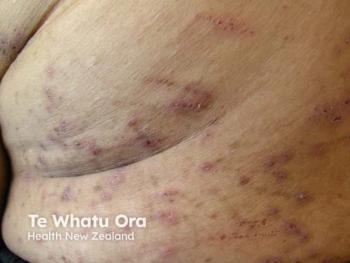
Addition of Niosomal Atorvastatin 1% Ointment to Therapy With Topical Calcineurin Inhibitor Yields No Additional Effect in Non-Segmental Vitiligo
The combination therapy did not yield any effect in patients with non-segmental vitiligo and prompts additional large studies prior to conclusive efficacy.
The addition of niosomal atorvastatin 1% ointment to topical calcineurin inhibitor 0.1% tacrolimus had no additional effect on non-segmental vitiligo, according to authors of a recent study published in the Journal of Cosmetic Dermatology.1
According to study authors Zartab et al, vitiligo continues to present treatment challenges, particularly in areas such as acral depigmentation. Statins, such as atorvastatin, they wrote, inhibit 3-hydroxy-3-methyl glutaryl coenzyme A reductase. There has been research evaluating the role of statins in neoplastic and inflammatory disorders, such as alopecia, melanoma, and more, most recently in seborrheic dermatitis.2 When used as an adjuvant therapy in seborrheic dermatitis, atorvastatin 5% lotion demonstrated comparable efficacy to betamethasone lotion in the treatment of scalp seborrheic dermatitis.2
The study employed a triple-blind, placebo-controlled design and enrolled patients with non-segmental vitiligo. Participants were randomly assigned to receive either topical 0.1% tacrolimus cream alongside 1% niosomal atorvastatin ointment or tacrolimus cream with a placebo ointment.
Treatment duration spanned 3 months, during which patients applied the formulations on a twice-daily basis. Investigator assessments included the Vitiligo Area Scoring Index (VASI), patient satisfaction surveys, and adverse event monitoring. Laboratory evaluations were conducted both at baseline and trial conclusion.
Among the 20 patients enrolled, 65% were female, with an average age of 34.9 years. Both intervention and control groups exhibited a statistically significant reduction in VASI scores post-treatment (p < 0.05).
However, no significant difference was observed between groups regarding VASI score change.
Adverse reactions, including pruritus and burning sensations, were minimal and comparable between groups. Patient satisfaction scores did not significantly differ between intervention and control arms.
The findings of this study align with previous investigations into statin-based therapies for vitiligo, study authors wrote. While atorvastatin holds promise due to its anti-inflammatory properties, this study did not demonstrate superiority over placebo in terms of repigmentation.
Similar trials with simvastatin and combination therapies have reported mixed results.3 Discrepancies among studies may stem from variations in sample size, treatment duration, and assessment methodologies.
"The result of this study indicates that adding of niosomal atorvastatin 1% ointment to topical calcineurin inhibitor has no additional effect on non-segmental type of vitiligo. Further large studies with different combinations are recommended before any conclusive result can be concluded on efficacy of statins in vitiligo," according to Zartab et al. "We suggest the future studies be performed using larger sample sizes and considering state of disease, and different combination therapy regimens."
References
- Zartab H, Aflatoonian M, Shamsi-Meymandi S, Hamed Zartab MD, et al. Assessing effectiveness of adding niosomal atorvastatin 1% ointment to topical calcineurin inhibitor treatment in non-segmental vitiligo. J Cosmet Dermatol. February 13, 2024. Accessed February 16, 2024.
https://doi.org/10.1111/jocd.16227 - Sobhan M, Gholampoor G, Firozian F, Mohammadi Y, Mehrpooya M. Comparison of efficacy and safety of atorvastatin 5% lotion and betamethasone 0.1% lotion in the treatment of scalp seborrheic dermatitis. Clin Cosmet Investig Dermatol. 2019; 12: 267-275.
- Niezgoda A, Winnicki A, Kosmalski T, Kowaliszyn B, Krysiński J, Czajkowski R. The evaluation of vitiligous lesions repigmentation after the administration of atorvastatin calcium salt and simvastatin-acid sodium salt in patients with active vitiligo (EVRAAS), a pilot study: study protocol for a randomized controlled trial. Trials. 2019; 20(1): 1-8.
Newsletter
Like what you’re reading? Subscribe to Dermatology Times for weekly updates on therapies, innovations, and real-world practice tips.


















